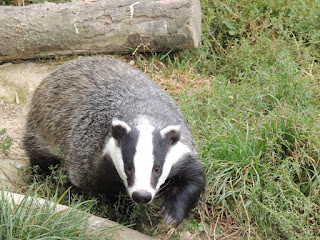Anglesey Abbey isn’t a place of worship, it is a country house not far from Cambridge. Originally a priory, it’s situated in the village of Lode and is surrounded by landscaped grounds, with various gardens filled with classical statues, topiary and flowerbeds. Some of the gardens are formal, while others are a glorious mix of trees, shrubs and ivy. Apparently, the gardens were laid out in a 18th century style by Lord Fairhaven in the 1930s. The house and grounds are now owned by the National Trust.
It’s a place we frequently return to; the gardens are attractive whatever the season. I went there a few days ago and the dahlias were in full bloom. Some of them were enormous, sporting huge cactus type pointed petal flowers, while others had symmetrical pom-pom blooms. The colours were intense: reds, purples, oranges, pinks and yellows, a feast of colour. Unfortunately, there isn’t room in our garden for such spectacular plants, but the sweeping dahlia-filled bed at Anglesey Abbey is a glorious sight. Another of the gardens was filled with smaller dahlias, and that was pretty too.
The rose garden was still in bloom, there was a beautiful magenta-coloured rose called Darcey Bussell, named for the ex prima ballerina, while another that caught my eye was an orange rose, ‘Lady of Shallot’. Although the herbaceous garden was past its best, there were still plenty of plants in colour, including some lovely deep blue delphiniums. I’ve always been fond of delphiniums, and whenever I see them recall the delightful poem by AA Milne, ‘The Dormouse and the Doctor’, which begins:
There once was a Dormouse who lived in a bed
Of delphiniums (blue) and geraniums (red),
And all the day long he'd a wonderful view
Of geraniums (red) and delphiniums (blue).
Amongst the trees we caught glimpses of cyclamen, and as we approached a wooded avenue we could see them stretching ahead like a pale pink carpet. The sun illuminated them, and it was a delightful sight; we weren’t the only people stopping to admire them. Soon we reached one of my favourite parts of the garden, a collection of Himalayan birch in the winter garden. Unlike the common birch, the bark on these trees doesn’t peel, and so the trunks are a bright silver/white. The effect is magical whatever time of year you visit – it’s almost as though the trees have been covered with whitewash!
We walked along the river, here men were scything and raking some of the vegetation, and we watched the moorhens with their almost-grown-up chicks. The Lode Mill, painted a bright white, was reflected in the water. The mill is open most days and you can climb up and see the machinery. You can buy flour from the mill, too. We were amazed at how many dragonflies there were, not just by the river but all around the gardens, on the lawns and by the trees. There were butterflies too; I noticed red admirals and small whites.
Soon, the trees will be turning red and gold – late autumn is a good time to visit Anglesey Abbey. But then, winter is a great time to visit too – in February this year we walked through the snow admiring the stunning colours of the dogwood and other shrubs in the winter garden. February is a good month for the glorious sight of thousands of snowdrops, too. And of course, spring at Anglesey Abbey is exquisite when the narcissi and other bulbs are in bloom, while in high summer it is a mass of colour…… whenever you go, it’s beautiful.
Of course, it’s possible to visit the house too, and we have done that several times. There is plenty to see there, from bedrooms to kitchens. One of the things to look out for is the collection of clocks, and there are many paintings, including some gorgeous ones of birds, as well as silver, china and furnishings. My favourite item is a tray with 18 ceramic tubes and wire clips. Apparently, it is a carnation box. Lord Fairhaven always wore a carnation – a coloured one during the day and a white one in the evening. This tray stored the readymade buttonholes, allowing him to wear a flower even when away from home. The lid bore the warning ‘Cut flowers in water. This way up.’
After we have explored, we always end up in the super café, with windows that look out onto the lawns. It’s a good place to relax with a cup of tea and something delicious to eat after walking around the house and gardens.
Yes I thoroughly recommend a visit to Anglesey Abbey – if you see me there, come and say hello!


















